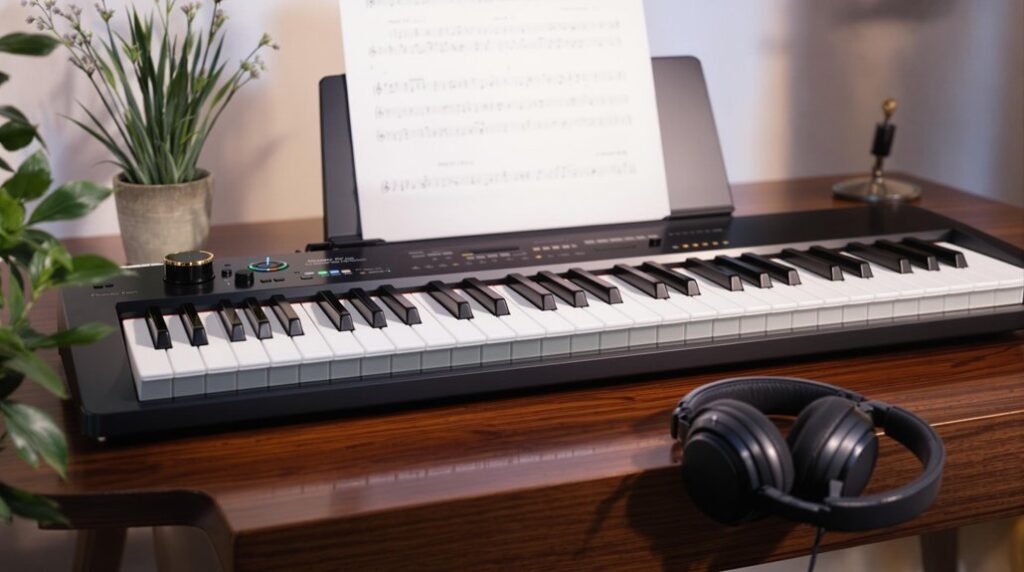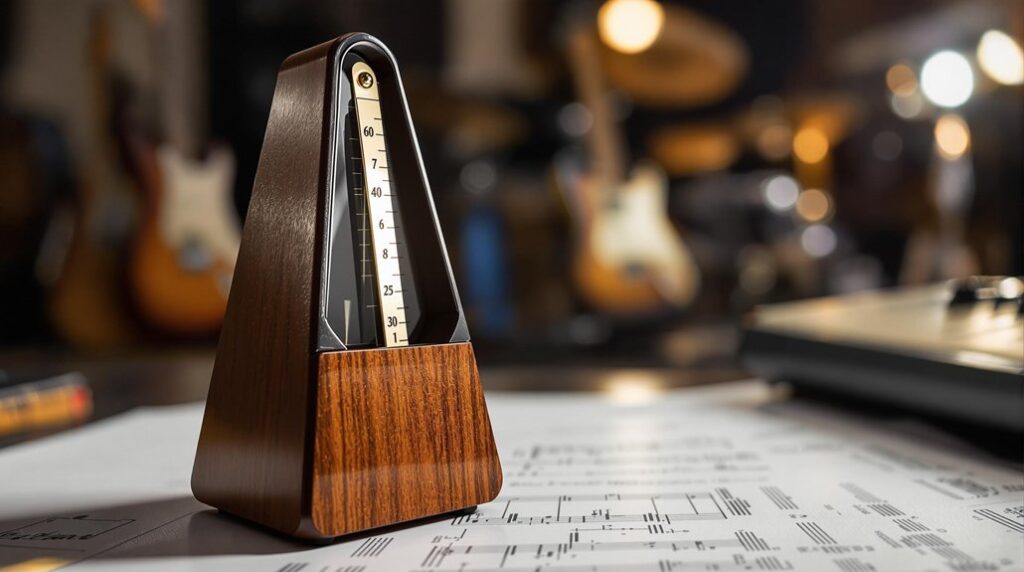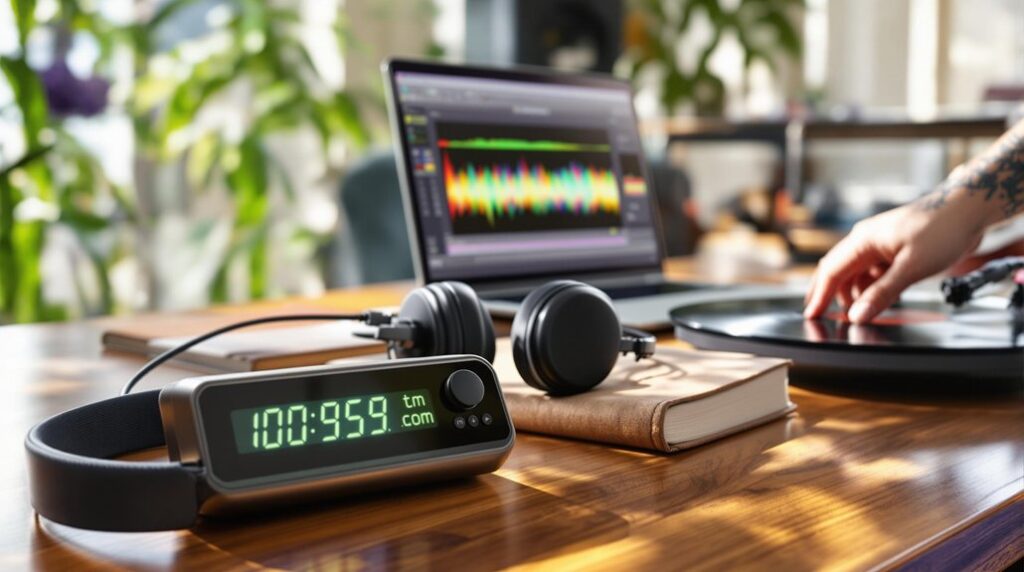When you talk about the beat in music, you’re referring to the song’s steady, recurring pulse. This pulse acts like the music’s heartbeat, guiding musicians and ensuring coherence. It’s different from rhythm, which introduces patterns of sounds and silences over this steady pulse. Understanding the beat is essential for keeping time and enhancing your musical skills. Beats are often grouped into measures, forming the foundation of musical structure. Learning about tempo, which dictates the speed of these beats, adds another layer to your music comprehension. Get ready to explore how all these elements come together to make music come alive.
Key Takeaways
- Beat is a steady, recurring pulse that acts as the song’s heartbeat and maintains timing.
- It guides musicians like an invisible metronome, ensuring coherence in performance.
- Distinguishing beat from rhythm is crucial; beat is the pulse, rhythm introduces patterns.
- Tempo influences the mood and energy of music, with specific terms guiding speed.
- Practicing with metronomes and rhythmic exercises improves timing and beat accuracy.
What Is a Beat?
A beat in music is the steady, recurring pulse that acts as the song’s heartbeat, keeping everything in sync. Imagine the beat as the invisible metronome that guides musicians through a piece, providing the essential foundation for rhythm.
The beat definition centers around its role as a consistent tempo marker that musicians rely on to maintain timing and coherence. Understanding the beat’s importance is pivotal whether you’re a seasoned musician or just starting. It helps you stay in time and synchronize with others, ensuring a harmonious performance.
Without a clear beat, music can quickly become chaotic and disorganized. Beats are usually counted in groups, creating patterns that form the musical structure you hear. These groups, often in twos, threes, or fours, are the building blocks of complex compositions.
Moreover, the beat serves as a reference point for organizing notes, rests, and musical phrases, giving a piece its distinctive feel and flow. By grasping the concept of the beat, you’ll find it easier to follow along with a song, whether you’re playing an instrument, singing, or just tapping your foot to the music.
Beat Vs. Rhythm
When you think about beat and rhythm, it’s essential to understand their distinct roles in music.
The beat is the steady pulse that keeps everyone in sync, while rhythm introduces variety with patterns of sounds and silences within that pulse.
Recognizing how these elements interplay will enhance your ability to interpret and perform any musical piece accurately.
Beat: Steady Musical Pulse
You can think of the beat in music as the steady, underlying pulse that keeps everything in time and guarantees all the elements fit together seamlessly. It’s the constant rhythm that you tap your foot to, providing the essential framework for musicians and listeners alike. The beat serves as the ‘heartbeat’ of the music, offering a consistent tempo that guides the entire piece.
Beat perception is important for both musicians and listeners. When you can accurately perceive the beat, your music interpretation becomes more instinctive and precise. This awareness allows you to feel the music’s pulse, making it easier to stay in sync with other performers and maintain the overall musical cohesion.
Distinguishing beat from rhythm is essential. While the beat is that steady pulse, rhythm involves the intricate patterns of sounds and silences that occur within that pulse. By understanding this foundational concept, you’ll be better equipped to appreciate and perform music with greater accuracy and expressiveness.
Internalizing the beat guarantees that all musical elements fit together seamlessly, creating a unified and harmonious performance. Remember, the beat isn’t just a background element—it’s the driving force that keeps the music alive and vibrant.
Rhythm: Patterns and Timing
Rhythm, unlike the steady beat, introduces patterns and timing variations that make music lively and expressive. While the beat provides a stable pulse, rhythm consists of sequences of sounds and silences arranged in time. This interplay creates the groove and flow that makes each piece unique.
Understanding rhythm is pivotal for achieving timing accuracy. When you grasp how rhythms fit within the beat, you can play or sing in sync with other musicians. This synchronization is essential for musical coordination, ensuring everyone stays on the same page and the performance sounds cohesive.
Rhythms often feature accents, syncopation, and varied note durations. These elements add complexity and interest to the music, transforming a simple beat into a compelling performance. Practicing rhythmic patterns helps you internalize these variations, improving your timing and ability to navigate different styles and genres.
To develop your rhythmic skills, start by clapping or tapping out patterns while keeping a steady beat. This practice enhances your timing accuracy and coordination, laying a solid foundation for more advanced musical endeavors.
Interplay: Beat and Rhythm
Building on your understanding of rhythm’s patterns and timing, let’s explore how beat and rhythm interact to shape the overall feel of a piece of music. The beat provides a steady pulse, creating a foundation that musicians rely on.
Rhythm, on the other hand, weaves through this pulse with patterns of sounds and silences, adding complexity and texture.
To better grasp this interplay, consider the following:
- Beat Dynamics: The strength and emphasis of the beat can vary, influencing how energetic or relaxed a piece feels. A strong beat might propel a dance track, while a subtle beat can add nuance to a ballad.
- Beat Accuracy: Maintaining a consistent beat is essential for musicians to stay in sync. Precision guarantees that the rhythm aligns well, preventing the music from sounding disjointed.
- Rhythmic Variations: While the beat stays constant, rhythmic patterns can change to create interest and variation. Syncopation, polyrhythms, and different time signatures all contribute to the diversity in music.
Understanding the difference between beat and rhythm, along with their interaction, is vital to mastering music. It allows you to appreciate the structure and creativity within compositions, helping you play more cohesively with others.
Time Signatures
To grasp the essence of time signatures, you need to understand how they dictate the rhythmic structure of a piece.
Time signatures, like 4/4 or 3/4, tell you both the number of beats per measure and which note gets the beat.
Types of Time Signatures
Understanding time signatures is crucial as they determine how many beats are in each measure and what type of note receives one beat. This fundamental aspect of music notation impacts the rhythmic feel and structure of a piece.
Let’s explore some common and uncommon types of time signatures, starting with compound meters.
Compound Meters
Compound meters are where each beat divides into three equal parts. A common example is 6/8, where there are six beats per measure, and each beat is an eighth note. This creates a triplet feel that’s often found in waltzes and marches.
Uncommon Time Signatures
Uncommon time signatures can offer unique rhythmic complexities. For example, 5/4 and 7/8 are less frequently used but can introduce an interesting twist to a composition. These signatures challenge both the musician and the listener, providing a departure from the more predictable patterns.
Common Time Signatures
- 4/4 Time: Also referred to as ‘common time,’ it consists of four beats per measure with the quarter note receiving one beat.
- 3/4 Time: Frequently used in waltzes, it includes three beats per measure.
- 2/4 Time: Popular in marches, it contains two beats per measure.
Reading Time Signatures
Reading time signatures is fundamental for musicians to accurately interpret and play the rhythmic structure of a piece. Time signatures give you the framework needed to understand how many beats are in each measure and which note value represents one beat.
This foundational knowledge, known as time signature basics, is vital for organizing and interpreting rhythm in any musical composition.
When you look at a time signature, the top number tells you how many beats are in a measure. For instance, in a 4/4 time signature, there are four beats per measure. The bottom number indicates the note value that gets one beat. In 4/4, the quarter note is the beat unit, while in 6/8, the eighth note takes that role.
Common time signatures like 4/4, 3/4, and 6/8 appear frequently in various musical genres. Mastering these will enhance your beat interpretation, enabling you to play music with the correct rhythm and timing.
Understanding time signatures isn’t just about counting beats; it’s about feeling the pulse of the music and translating that into your performance. So, immerse yourself in this rhythmic world and let the time signatures guide your musical journey.
Tempo in Music
Tempo in music, the speed at which beats are played, directly influences the overall mood and energy of a piece. When you immerse in tempo variations, you’ll notice how different speeds can evoke distinct emotional impacts. A fast tempo, like Allegro, often brings excitement and joy, while a slow tempo, such as Adagio, conveys calmness or melancholy. This ability to manipulate emotions makes tempo a potent tool in musical expression.
Understanding the importance of tempo consistency can’t be emphasized enough. Consistent tempo guarantees that musicians stay synchronized, creating a cohesive and polished performance. Here’s why tempo matters:
- Emotional Impact: The right tempo can make the listener feel a range of emotions, from happiness to sadness.
- Performance Precision: Musicians need to maintain a steady tempo to ensure their parts align perfectly.
- Audience Engagement: A consistent tempo keeps the audience engaged and helps them follow the musical narrative.
Tempo markings at the beginning of a piece guide musicians on the intended speed. These can be expressed in terms like Allegro or Adagio, or numerical values like BPM (beats per minute).
Practice Tips
Now that you understand how tempo shapes musical expression, let’s explore practical tips to help you internalize and maintain a steady beat.
Start with rhythmic exercises like tapping your foot or clapping along with your favorite songs. This helps you feel the musical pulse and strengthens your sense of timing. Beat visualization techniques, such as imagining the beat as a bouncing ball, can also be effective in keeping you aligned with the rhythm.
Using a metronome is another excellent way to stay on beat. Begin with a comfortable tempo and gradually increase it as you improve. Timing drills, where you practice playing or singing along with the metronome, can notably enhance your precision and consistency.
Experiment with different beats and rhythms to diversify your understanding. Playing simple percussion instruments, like a tambourine or bongos, can deepen your grasp on maintaining a steady beat. This hands-on approach makes it easier to internalize the concept of timing.
Learning Resources
You’ll find a wealth of resources to help you understand the meaning of beat in music, from online platforms like ARTS:LIVE to educational programs offered by The Song Room. These resources cater to different learning styles and preferences, ensuring you grasp the fundamental concepts of beat and rhythm.
- Online tutorials and interactive games: Platforms such as ARTS:LIVE offer detailed lessons and interactive activities. These engaging tools help you internalize beat concepts through practice and repetition.
- Collaborative workshops and peer feedback: Enrolling in programs provided by The Song Room allows you to participate in collaborative workshops. Here, you can interact with music educators and peers, gaining valuable feedback and insights that enhance your understanding.
- The Music Classroom Collection: This resource is packed with materials specifically focused on teaching the beat. It’s an excellent way for both learners and educators to dive deep into the subject matter.
Frequently Asked Questions
How to Understand Beat in Music?
To understand beat in music, start by counting beats consistently. Feel the rhythm by tapping your foot or clapping hands. Practice with a metronome to stay in time and sync with the music’s pulse.
What Is the Simple Definition of Beat in Music?
The beat in music is the basic explanation of the steady pulse you feel in rhythmic patterns. It’s like a musical heartbeat that helps musicians stay in sync and maintain the song’s timing.
How to Learn Rhythm in Music for Beginners?
To learn rhythm in music, start with rhythm exercises like clapping or tapping along to songs. Metronome practice is essential; it helps you stay in time and improve your rhythmic accuracy. Experiment with different tempos too!
How to Explain a Beat to a Child?
To explain a beat to a child, show them beat visualization by tapping your foot. Get them involved with beat clapping. Tell them the beat is like a steady heartbeat they can feel and move to in a song.
Conclusion
Now you’ve got a solid grasp on the basics of the beat in music! Understanding the difference between beat and rhythm, recognizing time signatures, and paying attention to tempo will enrich your musical journey.
Don’t forget to practice regularly and use the resources available to you. With dedication and curiosity, you’ll find yourself becoming more confident and skilled.
Keep exploring, and enjoy the rhythm of your musical adventure!




